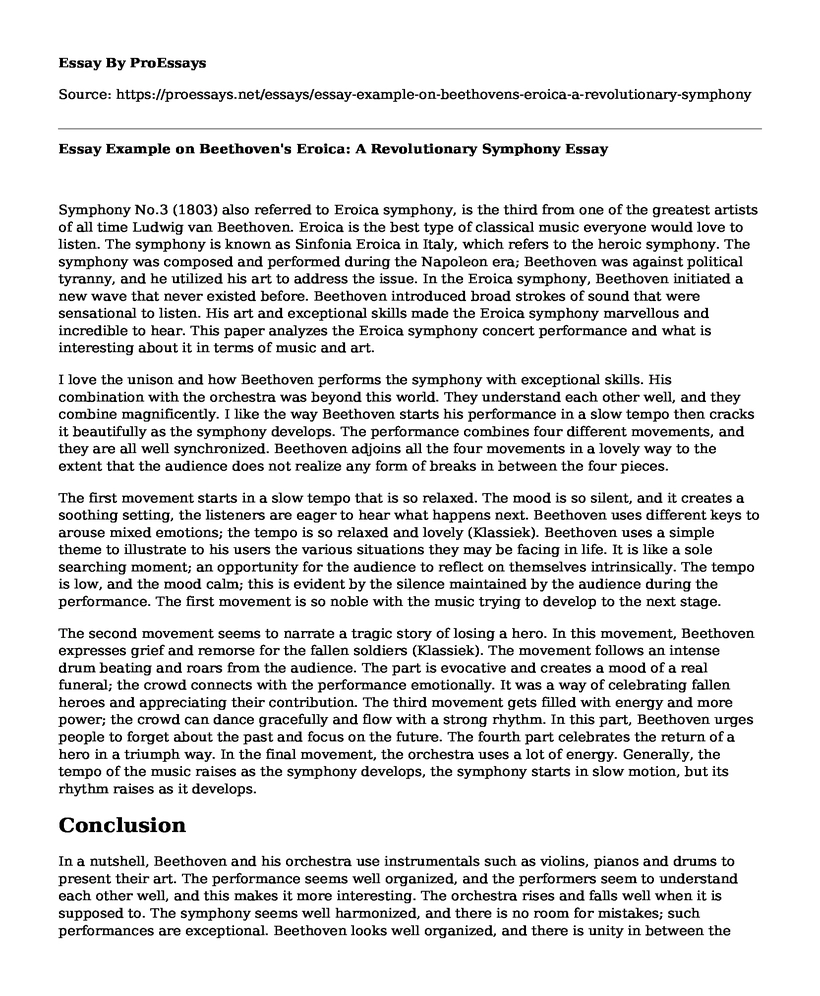Symphony No.3 (1803) also referred to Eroica symphony, is the third from one of the greatest artists of all time Ludwig van Beethoven. Eroica is the best type of classical music everyone would love to listen. The symphony is known as Sinfonia Eroica in Italy, which refers to the heroic symphony. The symphony was composed and performed during the Napoleon era; Beethoven was against political tyranny, and he utilized his art to address the issue. In the Eroica symphony, Beethoven initiated a new wave that never existed before. Beethoven introduced broad strokes of sound that were sensational to listen. His art and exceptional skills made the Eroica symphony marvellous and incredible to hear. This paper analyzes the Eroica symphony concert performance and what is interesting about it in terms of music and art.
I love the unison and how Beethoven performs the symphony with exceptional skills. His combination with the orchestra was beyond this world. They understand each other well, and they combine magnificently. I like the way Beethoven starts his performance in a slow tempo then cracks it beautifully as the symphony develops. The performance combines four different movements, and they are all well synchronized. Beethoven adjoins all the four movements in a lovely way to the extent that the audience does not realize any form of breaks in between the four pieces.
The first movement starts in a slow tempo that is so relaxed. The mood is so silent, and it creates a soothing setting, the listeners are eager to hear what happens next. Beethoven uses different keys to arouse mixed emotions; the tempo is so relaxed and lovely (Klassiek). Beethoven uses a simple theme to illustrate to his users the various situations they may be facing in life. It is like a sole searching moment; an opportunity for the audience to reflect on themselves intrinsically. The tempo is low, and the mood calm; this is evident by the silence maintained by the audience during the performance. The first movement is so noble with the music trying to develop to the next stage.
The second movement seems to narrate a tragic story of losing a hero. In this movement, Beethoven expresses grief and remorse for the fallen soldiers (Klassiek). The movement follows an intense drum beating and roars from the audience. The part is evocative and creates a mood of a real funeral; the crowd connects with the performance emotionally. It was a way of celebrating fallen heroes and appreciating their contribution. The third movement gets filled with energy and more power; the crowd can dance gracefully and flow with a strong rhythm. In this part, Beethoven urges people to forget about the past and focus on the future. The fourth part celebrates the return of a hero in a triumph way. In the final movement, the orchestra uses a lot of energy. Generally, the tempo of the music raises as the symphony develops, the symphony starts in slow motion, but its rhythm raises as it develops.
Conclusion
In a nutshell, Beethoven and his orchestra use instrumentals such as violins, pianos and drums to present their art. The performance seems well organized, and the performers seem to understand each other well, and this makes it more interesting. The orchestra rises and falls well when it is supposed to. The symphony seems well harmonized, and there is no room for mistakes; such performances are exceptional. Beethoven looks well organized, and there is unity in between the movements, and this makes his art interesting to listen. During the previous times of Mozart, movements were connected through clapping in between, but Beethoven seems to have a unique way of synchronizing them. Beethoven's exceptional ability to read society and include it in his music makes him an outstanding artist. Through the Eroica symphony, he was able to express his opinion during the Napoleon era. It is always great to look back to these periods, Beethoven's performances give me a sensational feeling, and I always admire how he did it so incredibly.
Work Cited
Klassiek, Avrotros. "Beethoven: Symphony no. 3 Eroica - Philippe Herreweghe." Youtube, 21 Feb. 2011, https://youtu.be/kwRVR-TmKYw
Cite this page
Essay Example on Beethoven's Eroica: A Revolutionary Symphony. (2023, May 08). Retrieved from https://proessays.net/essays/essay-example-on-beethovens-eroica-a-revolutionary-symphony
If you are the original author of this essay and no longer wish to have it published on the ProEssays website, please click below to request its removal:
- The Glass Menagerie Play by Tennessee Williams Essay
- The Big Short Essay Example
- Everybody Rides the Carousel - Film Analysis Essay
- Essay Example on Crazy Rich Asians: A Commoner Among The Rich
- Paper Example on Facebook: Social Media Giant Leveraging Web-Based Technology
- Essay Example on Exploring the Arts: A Journey of Passion and Discovery
- Research Paper Sample on Role of Female Directors







